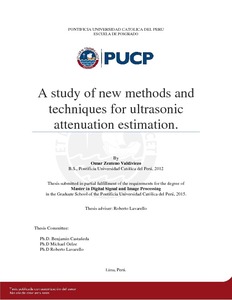| dc.contributor.advisor | Lavarello Montero, Roberto Janniel | |
| dc.contributor.author | Zenteno Valdiviezo, Omar Jonathan | es_ES |
| dc.date.accessioned | 2017-03-09T21:55:19Z | es_ES |
| dc.date.available | 2017-03-09T21:55:19Z | es_ES |
| dc.date.created | 2015 | es_ES |
| dc.date.issued | 2017-03-09 | es_ES |
| dc.identifier.uri | http://hdl.handle.net/20.500.12404/8134 | |
| dc.description.abstract | The pathological states of biological tissue are often related in attenuation changes of itself. Thus,
information about attenuating properties of tissue is valuable for the physician and could be useful in
ultrasonic diagnosis. However, accurate characterization of tissue pathologies using ultrasonic
attenuation is strongly dependent on the accuracy of the algorithm that is used to obtain the attenuation
coefficient estimates.
In the present document, we derive a new attenuation estimation method which uses the analytical
backscatter coefficient (BSC) diffraction compensation function for single-element transducers
proposed by Chen et al. and compare it to a reference phantom attenuation estimation method. The
accuracy of the two methods was evaluated. The results showed that an accurate attenuation
coefficient mean value can be estimated by the two methods presenting a low mean percentile error
(MPE<6%). However, the coefficient of variation of the estimates remains higher than the desired
values (CV>62%).
Moreover, to remove the inherent size of the ROI’s limitation due to the high variability of the
estimator, the use of full angular spatial compounding was extended to the estimation of attenuation
coefficients and its performance was experimentally evaluated using two physical phantoms. The
results suggest that the variance and field of view of attenuation imaging can be significantly
improved without sacrificing estimation accuracy.
Based on these observations, the analytic diffraction compensation method was applied in an animal
model to estimate the mean attenuation value of thyroids lobes. To reduce variability on the estimates,
a three neighboring layer spatial compounding approach was applied. The results suggest the mean
attenuation value can potentially discriminate a particular pathology on thyroid from malignant and
normal tissues.
The final conclusions lead to remark the potential of parametric imaging of tissue attenuation by the
analytic diffraction compensation method in conjunction with spatial compounding as a useful tool
for medical detection and diagnostic. | es_ES |
| dc.description.uri | Tesis | es_ES |
| dc.language.iso | eng | es_ES |
| dc.publisher | Pontificia Universidad Católica del Perú | es_ES |
| dc.rights | info:eu-repo/semantics/closedAccess | es_ES |
| dc.subject | Ultrasonido | es_ES |
| dc.subject | Ingeniería biomédica | es_ES |
| dc.title | A study of new methods and techniques for ultrasonic attenuation estimation | es_ES |
| dc.type | info:eu-repo/semantics/masterThesis | es_ES |
| thesis.degree.name | Maestro en Procesamiento de Señales e Imágenes Digitales. | es_ES |
| thesis.degree.level | Maestría | es_ES |
| thesis.degree.grantor | Pontificia Universidad Católica del Perú. Escuela de Posgrado | es_ES |
| thesis.degree.discipline | Procesamiento de Señales e Imágenes Digitales | es_ES |
| renati.advisor.dni | 10544227 | |
| renati.discipline | 613077 | es_ES |
| renati.level | https://purl.org/pe-repo/renati/level#maestro | es_ES |
| renati.type | http://purl.org/pe-repo/renati/type#tesis | es_ES |
| dc.publisher.country | PE | es_ES |
| dc.subject.ocde | https://purl.org/pe-repo/ocde/ford#2.02.05 | es_ES |





